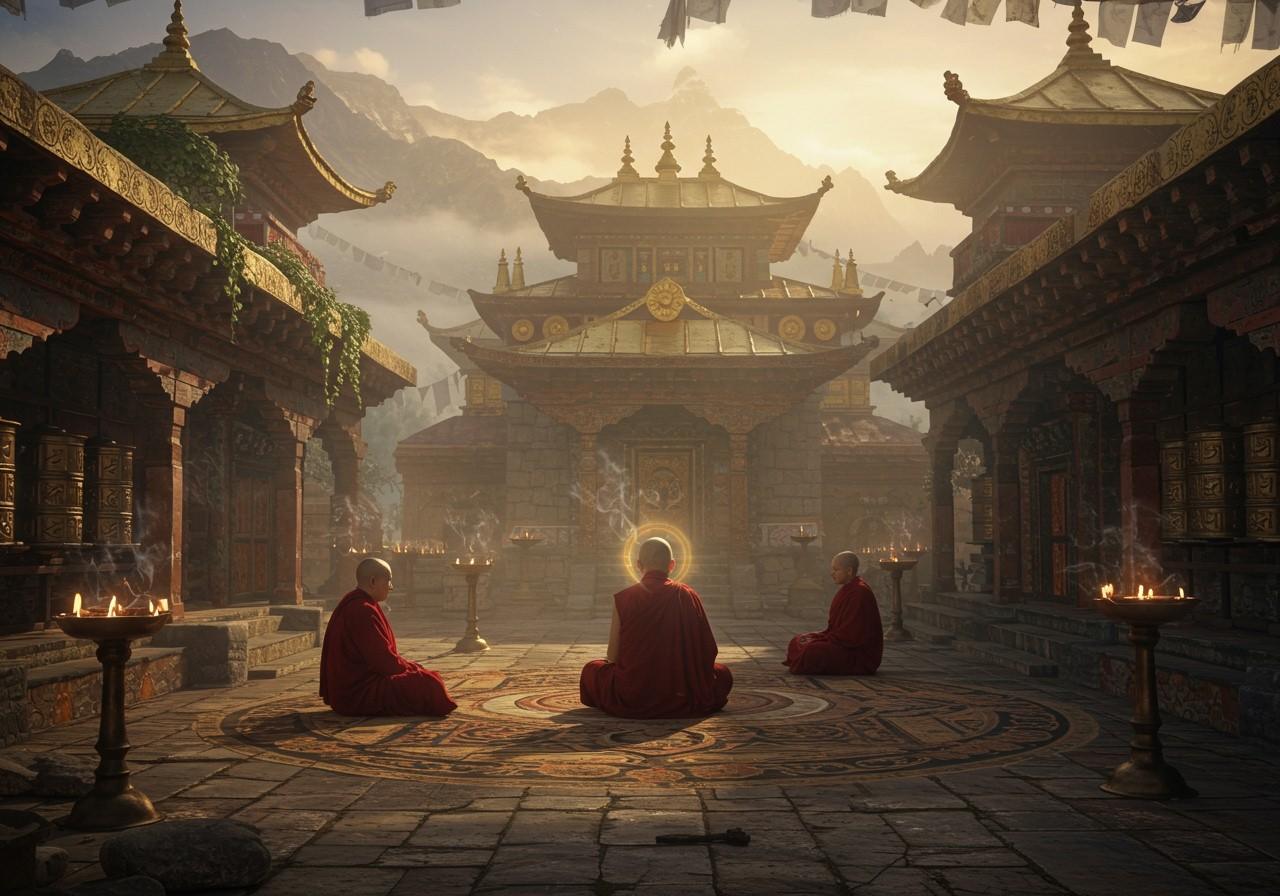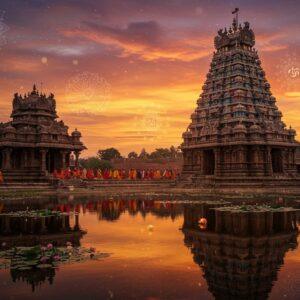
Buddhist monasteries and monks hold a significant place in the spiritual heritage of Buddhism, playing a vital role in preserving and sharing its teachings. This guide offers insights into the life within the Sangha (the monastic community) and their monasteries.
Understanding Buddhist Monasteries
Buddhist monasteries, known as ‘Viharas,’ are more than just places of worship. They function as educational and communal centers for monks. Key features include the main hall (Buddha Hall), meditation rooms, and living quarters. Monasteries have a rich history, evolving from ancient India (5th and 4th centuries BCE) to their present-day forms.
These sanctuaries are essential for preserving sacred texts and fostering learning and practice. Notable monasteries include:
- Nalanda (India)
- Shaolin Temple (China)
- Wat Phra Dhammakaya (Thailand)
Daily Life of a Buddhist Monk
A Buddhist monk’s life is characterized by simplicity, discipline, and devotion. Their day typically begins before dawn with meditation and chanting, followed by communal meals and study. Shaving the head and wearing robes are symbolic acts of renunciation and humility. Alms-giving is a vital practice, connecting monks with the lay community. Meditation and mindfulness are central to their daily routine, along with adherence to vows like the Five Precepts and Vinaya rules. Retreats provide opportunities for deeper spiritual exploration.
Where Buddhist Monks Live
Monasteries offer an environment conducive to spiritual practice and communal living. They have a hierarchical structure, with senior monks and novices sharing responsibilities. Monks live collectively, participating in communal activities. Monasteries can be found in diverse locations, from remote mountain retreats to urban centers. Living in nature often has a positive impact on a monk’s spiritual practice. Living conditions vary, ranging from simple huts to elaborate temple complexes. Seasonal movements, such as the monastic rainy season retreat (Vassa), are also common.
Spiritual Practices and Rituals
Spiritual practices are fundamental to a monk’s path to enlightenment. Various meditation forms, including Vipassana and Zen, are practiced. Chanting and reciting sutras are important daily rituals. Mindfulness cultivates mental clarity and emotional stability. Pilgrimages to sacred sites like Bodh Gaya and Lumbini hold deep significance. Mindfulness is integrated into everyday activities like walking and eating. Annual rituals, such as the Buddhist New Year and Vesak celebrations, are also observed. Silent retreats offer extended periods for deep meditation.
Education and Learning
Education in a Buddhist monastery emphasizes spiritual and intellectual growth. Monks delve into Buddhist scriptures, philosophy, and languages like Pali or Sanskrit. Senior monks mentor novices, guiding their spiritual development. Debate and discussion facilitate a deeper understanding of the teachings. Modern monasteries may incorporate contemporary subjects and vocational training. The teacher-disciple relationship is crucial for transmitting knowledge. Renowned scholars contribute significantly to Buddhist studies. Monasteries preserve knowledge through publishing and academic collaborations.
Interaction with the Lay Community
Monks play a vital role in the spiritual lives of laypeople. Alms-giving fosters a reciprocal relationship between monks and the community. Monks perform rituals like blessings and funerals. Monasteries often provide social services such as education and healthcare. Annual festivals bring monks and laypeople together, strengthening community bonds. Laypeople support monasteries through donations and volunteer work. Modern technology, including social media, facilitates communication between monks and the wider community.
Buddhist monastic life is diverse, with regional variations in practices and traditions. Despite these differences, the core values of discipline, community, and spiritual growth remain central.
How Poojn Supports Buddhist Monasteries and Monks
Poojn.in offers a wide selection of items essential for Buddhist monasteries and monks’ daily rituals and practices. Our collection includes:
- Holy Idols: Authentic Buddha statues in various sizes and materials, ideal for monastery shrines and personal meditation. We ensure these meet traditional specifications and religious requirements.
- Holy Food: A range of pure, ritual-appropriate food items suitable for Buddhist dietary practices. We prioritize items aligning with Buddhist dietary guidelines, providing proper sustenance for monks’ spiritual journeys.
We deliver these sacred items directly to monasteries across India, ensuring convenient access to authentic ritual items. Our online platform simplifies browsing and ordering, allowing for efficient procurement. Visit www.poojn.in to explore our full range of Buddhist ritual items and holy food products. We ensure respectful handling and careful packaging of all sacred items.
Note: Product availability may vary. Please check the website for current stock.
Conclusion: Embracing the Sangha
The life of a Buddhist monk is a path of discipline, devotion, and profound spiritual growth, nurtured within the supportive environment of monasteries. Their daily routines and spiritual practices, rooted in ancient traditions, guide them toward enlightenment. Understanding the role of Buddhist monasteries and the monastic community provides valuable insights into Buddhism’s spiritual heritage, highlighting the timeless wisdom they offer. By supporting monasteries and engaging with monks, we can deepen our connection with our own spiritual paths. Embrace the Sangha, and let it inspire your journey of peace and enlightenment.
FAQs: Life in the Sangha
What is a Buddhist monastery? A Buddhist monastery, often called a vihara, provides a communal setting for monks (and sometimes nuns) to reside, meditate, study, and practice Buddhist teachings. It is a place dedicated to the pursuit of spiritual development and the preservation of Buddhist traditions.
Who are Buddhist monks? Buddhist monks are individuals who have dedicated their lives to following the teachings of the Buddha. They typically reside in monasteries, embracing a life of meditation, study, and service to the community. Their daily lives revolve around spiritual practices and adherence to monastic rules.
Where do Buddhist monks live? Buddhist monks primarily live in monasteries, which can range from simple dwellings in remote natural settings to more elaborate complexes in urban areas. The location of a monastery often reflects the specific tradition or lineage of Buddhism practiced within.
What do Buddhist monks do daily? A Buddhist monk’s daily routine is structured around spiritual practices. This includes meditation, chanting, studying Buddhist scriptures, and engaging in communal activities. They also may participate in alms rounds, receiving food offerings from the lay community.
Can anyone become a Buddhist monk? Generally, yes, anyone who sincerely wishes to follow the Buddhist path can become a monk. The process typically involves a period of training and adherence to specific vows and monastic rules. Acceptance into the Sangha is dependent on meeting the requirements of the specific monastic community.
What is the purpose of living in a Buddhist monastery? The primary purpose of monastic life is to cultivate spiritual growth and progress towards enlightenment. The structured environment of a monastery facilitates focused meditation practice, study of Buddhist teachings, and the development of ethical conduct.
How do Buddhist monasteries support themselves? Monasteries typically rely on the generosity of the lay community for support. This can include donations of food, money, and other essential resources. Some monasteries may also engage in activities like producing handicrafts or offering retreats to generate income.
What is the Sangha? The Sangha refers to the Buddhist monastic community. It encompasses both monks and nuns who have taken vows and dedicated themselves to the Buddhist path. The Sangha plays a crucial role in preserving and transmitting the Buddha’s teachings.
For further insights into related topics, explore these articles:
Poojn.in also offers relevant products that may enhance your spiritual practice:


